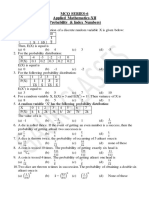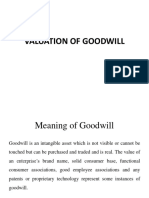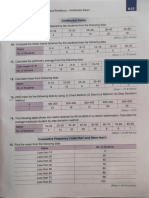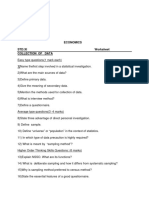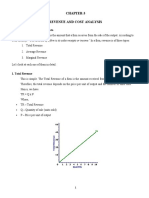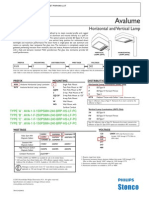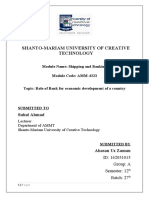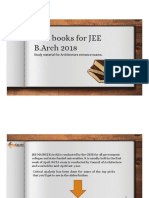12/07/21 1
At the end of this topic you will be able to:
Define probability
Describe the classical, empirical and subjective
approaches to probability
Understand the terms experiment, event, outcome
Define the terms conditional probability and joint
probability
12/07/21 2
� Calculate probabilities using the rules of addition and
the rules of multiplication
12/07/21 3
� Descriptive statistics is concerned with summarizing
data collected from past events.
We turn to the second facet of statistics, namely,
computing the chance that something will occur in the
future.
This facet of statistics is called statistical inference or
inferential statistics
12/07/21 4
�• Statistical inference deals with conclusions about a
population based on a sample taken from that
population.
• Because there is uncertainty in decision making, it is
important that all the known risks involved be
scientifically evaluated.
• Helpful in this evaluation is probability theory, which
has often been referred to as the science of uncertainty.
12/07/21 5
� The use of probability theory allows the decision maker
with only limited information to analyze the risks and
minimize the gamble inherent, for example, in
marketing a new product or accepting an incoming
shipment possibly containing defective parts.
12/07/21 6
�• It is a number that describes the chance that something
will happen. This number lies between zero and one.
• The closer a probability is to 0, the more improbable it
is the event will happen.
• The closer the probability is to 1, the more sure we are
it will happen. Three key words are used in the study of
probability: experiment, outcome and event
12/07/21 7
� Experiment: is a process that leads to the occurrence
of one and only one of several possible observations.
An experiment has two or more possible results and it
is uncertain which will occur for example rolling a die.
Outcome: this is a particular result of an experiment.
12/07/21 8
� For example, the tossing of a coin is an experiment.
You may observe the toss of a coin but you are unsure
whether it will come up ‘heads’ or ‘tails’.
When one or more of the experiment’s outcomes are
observed, we call this an event. For example all
possible outcomes from a toss of a die are [1, 2, 3, 4, 5,
6]
12/07/21 9
� Event: this is a collection of one or more of an
experiment for example some possible events from a
roll of die are; observe an even number, observe a
number greater than 3 or observe a number 4 or less.
12/07/21 10
� Example
Consider the following experiment. Toss a coin and
observe whether the upside of the coin is Head or Tail.
Two events may be occurred:
H: Head is observed,
T: Tail is observed.
The probability of an event A, denoted by P(A), in
general, is the chance A will happen.
12/07/21 11
� Two approaches to assigning probabilities are the
objective and subjective view points.
Objective probability is subdivided into
1. Classical probability
2. Empirical probability
12/07/21 12
� Classical probability
This is based on the assumption that the outcomes of an
experiment are equally likely.
Using the classical view point, the probability of an
event happening is computed by dividing the number
of favorable outcomes by the number of possible
outcomes:
12/07/21 13
� The probability P(A) of an event A is equal to the
number of possible simple events (outcomes) favorable
to A divided by the total number of possible simple
events of the experiment, i.e.,
12/07/21 14
�where m= number of the simple events into which the event A
can be decomposed.
12/07/21 15
� Example:
Consider an experiment of rolling a six-sided die. What
is the probability of the event “an even number of spots
face up
Solution:
The possible outcomes are [1, 2, 3, 4, 5, 6]
12/07/21 16
� The favorable outcomes [2, 4, 6]
Therefore the probability of an even number = 3/6= 0.5
Example
Consider again the experiment of tossing a balanced
coin (see Example 4.1). In
this experiment the sample space consists of two
simple events: H (Head is observed ) and T(Tail is
observed ). These events are equally likely.
Therefore, P(H)=P(T)=1/2.
12/07/21 17
� Mutually exclusive events
Under these events, the occurrence of one event means
that none of the other events can occur at the same
time.
The variable “gender” presents mutually exclusive
outcome, male or female.
For instance, an employee selected at random is either
male or female but can not be both.
12/07/21 18
� If an experiment has a set of events that includes every
possible outcome, such as the events “an even number”
and “an odd number” in the die-tossing experiment,
then the set of events is collectively exhaustive.
For the die tossing experiment, every outcome will be
either even or odd.
Thus, in collective exhaustive events, at least one of the
events must occur when an experiment is conducted.
12/07/21 19
� Empirical probability:
Another way to define probability is based on relative
frequencies. The probability of an event happening is
determined by observing what fraction of the time
similar events happened in the past.
12/07/21 20
� In terms of a formula:
Probability of event happening= Number of times
event occurred in the past/ Total number of
observations.
12/07/21 21
� Subjective probability
If there is little or no past experience or information on
which to base a probability, it may be arrived at
subjectively.
Essentially, this means an individual evaluates the
available opinions and other information and then
estimates or assigns the probability.
12/07/21 22
� This probability is aptly called a subjective probability.
Thus, subjective concept of probability means that a
particular event happening which is assigned by an
individual based on information available e.g.
estimating the likelihood that you will earn an A in this
module
12/07/21 23
� For every event A of the field S,
P A 0
If the event A is decomposed into the mutually
exclusive events B and C belonging to S then
P(A)=P(B)+P(C)
This property is called the theorem on the addition of
probabilities.
The probability of the event A complementary to the
event A is given by the formulaP A = 1− P(A) .
The probability of the impossible event is zero, P(0)=0.
12/07/21 24
� The probability of any event A lies between 0 and 1:
0 P A 1
12/07/21 25
� Rules of addition
Special rule of addition
To apply the special rule of addition, the events
mutually exclusive.
If two events A and B are mutually exclusive, the
special rule of addition states that the probability of one
or the other event’s occurring equals the sum of their
probabilities
12/07/21 26
� i.e. P(A or B)= P(A) + P(B)
For three mutually exclusive events designated A, B
and C, the rule is written as
P(A or B or C)= P(A) + P(B) + P(C)
12/07/21 27
� Given the following information in the table
below:
Weight Event Number of Probability
packages of
occurrence
Underweigh A 100 0.025
t
Satisfactory B 3600 0.900
Overweight C 300 0.075
Total 4000 1.000
12/07/21 28
� What is the probability that a particular package will be
either underweight or overweight?
Solution
P(A) + P(C)= 0.025 + 0.075
= 0.10
12/07/21 29
� A Venn diagram is a useful tool to depict addition or
multiplication rules.
Assuming you have 3 mutually exclusive events A, B
and C, they can be illustrated diagrammatically by use
of Venn diagrams as shown below:
12/07/21 30
�Event Event Event
A B C
12/07/21 31
� This is used to determine the probability of an event
occurring by subtracting the probability of the event
not occurring from 1. i.e.
P A 1 P A
12/07/21 32
� A Venn diagram illustrating the complement rule is
shown as
Even
t
A A
12/07/21 33
� Use the complementary rule to show the probability of
a satisfactory bag is 0.900.
Show the solution using a Venn diagram
Solution
The probability that the bag is unsatisfactory equals:
P(A) + P(C)= 0.025 + 0.075
=0.100
12/07/21 34
� But the bag is satisfactory if it is not under or
overweight i.e.
P(B)= 1- [P(A) + P(C)]
= 1- 0.100
= 0.900
12/07/21 35
� Aor C 0.900
A C
0.025 0.075
12/07/21 36
� A sample of employees of Worldwide Enterprise is to
be surveyed about a new pension plan. The employees
are classified as follows;
Classification Event Number of
employee
Supervisors A 120
Maintenance B 50
Production C 1460
Management D 302
Secretarial E 68
12/07/21 37
� a) What is the probability that the first person selected
is:
i) either in maintenance or a secretary?
ii) not in management?
b) Draw a Venn diagram illustrating your answers to
part a)
c) Are the events in part a) i) complementary or
mutually exclusive or both?
12/07/21 38
� The outcomes of an experiment may not be mutually
exclusive.
When two or more events both occur concurrently, the
probability is called joint probability
12/07/21 39
� The following Venn diagram shows three events are
not mutually exclusive
12/07/21 40
�12/07/21 41
� This rule for two events designated A and B is written
P(A or B)= P(A) + P(B)- P(A and B)…………….1
Equation 1 is what we call the general rule for addition.
12/07/21 42
� Thus, if we compare the general and specific rules of
addition, the important difference is determining if the
events are mutually exclusive.
If the events are mutually exclusive, then the joint
probability P(A and B)= 0 and we could use the special
rule of addition.
12/07/21 43
� 1) The events A and B are mutually exclusive. Suppose
P(A)=0.3 and P(B)=0.2. What is the probability of
either A or B occurring?
What is the probability that neither A nor B will
happen?
2) The probabilities of the events A and B are 0.2 and
0.3 respectively. The probability that both A and B
occur is 0.15. What is the probability of either A or B
occurring?
12/07/21 44
� Special rule of multiplication
This requires that two events A and B are independent.
Two events are independent if the occurrence of one
event does not affect the probability of the occurrence
of the other event.
12/07/21 45
� For two independent events A and B, the probability
that A and B will both occur is found by multiplying
the two probabilities i.e.
P(A and B)= P(A).P(B)
For 3 independent events A, B and C will be
P(A and B and C)= P(A).P(B).P(C)
12/07/21 46
� A survey by the American Automobile Association
(AAA) revealed 60% of its members made airline
reservations last year. Two members are selected at
random. What is the probability both made airline
reservations last year?
12/07/21 47
�P( R1 ) 60%
P( R2 ) 60%
12/07/21 48
� Where R1andR2
First and second members made reservation.
Since the number of AAA members is very large, you
may assume that the above members are independent.
Therefore;
12/07/21 49
�P( R1andR2 ) P R1 .P R2 0.60 0.60 0.36
12/07/21 50
� This is the probability of a particular event occurring,
given that another event has occurred.
It can be written as
Conditional probability of A given B
12/07/21 51
� P AandB
PA
B
P B
12/07/21 52
� Conditional probability of B given A
PB
P AandB
A P A
12/07/21 53
� Symbolically, the joint probability P(A and B) is found
by
B
P AandB P B .P A
P AandB P A.P B
A
12/07/21 54
� Suppose P(A)= 0.40 and P(B/A)=0.30. What is the
joint probability of A and B
P(A and B)= P(A). P(B/A)
= 0.40 0.30
= 0.12
12/07/21 55
� If the number of possible outcomes in an experiment is
small, it is relatively easy to count them.
There are six possible outcomes, for example, resulting
from the roll of a die.
12/07/21 56
� If there are m ways of doing one thing and n ways of
doing another thing, there are m n ways of doing
both
In terms of a formula
Total number of arrangements = (m)(n).
The multiplication formula is applied to find the
number of possible arrangements for 2 or more groups
12/07/21 57
� Is any arrangement of r objects selected from a single
group of n possible objects.
Note that the arrangements a b c and b a c are different
permutations.
The formula to count the total number of different
permutations is
n!
n Pr
n r !
12/07/21 58
� Where n= the total number of objects
r= the number of objects selected
n! means n(n-1)(n-2)(n-3)…………….1
For instance 6! 6(5)(4)(3)(2)(1)=720
12/07/21 59
� 3 electronic parts are to be assembled into a plug-in
unit for a TV set. The parts can be assembled in any
order. In how many different ways can the 3 parts be
assembled?
3! 3! 3 2 1
n Pr 6
3 3! 0! 1
12/07/21 60
� The Betts Machine shop inc, has eight screw machines
but only three spaces available in the production area
for the machines. In how many different ways can the
eight machines be arranged in the three spaces
available?
12/07/21 61
� If the order of the selected objects is not important, any
selection is called a combination. The formula to
count the number of r object combinations from a set of
n objects is;
n!
n Cr
r! n r !
12/07/21 62
� Solve the following
5! 5 4 3 2 1
5 C2 10
2! 5 2! (2 1)(3 2 1)
12/07/21 63
� Solve the following
7 P4
9 P3
7 C2
6 C4
12/07/21 64





